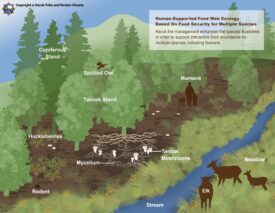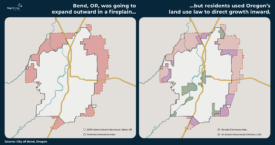Local communities can often see connections between pollution and environmental health long before big government agencies respond.
That’s what happened on the Oregon Coast in 2017 when a small group of citizens banded together to pass a ballot measure that would ban aerial pesticide spraying. It all started when a small group of citizens in Lincoln County grew concerned after watching planes and helicopters douse the forests around their community with a cocktail of chemical pesticides and fungicides. Worried about the potential impacts of spray drifting into their water supplies and affecting the health of people and animals, they started a campaign to ban the practice. They noted that the US Forest Service already banned the practice over national forests in 1984—and yet timber companies continued to apply chemicals from aircraft onto private forest land in Lincoln County and other parts of the Northwest.
In spite of bitter opposition by chemical industry groups that spent nearly $34 per voter (at least 22 times as much as the measure’s backers), the measure passed by a razor-thin margin of 61 votes out of nearly 14,000 ballots cast. It was a victory against long odds and a temporary one. Two private landowners subsequently filed suit against the measure, claiming that Oregon state law preempts the local initiative.
Lincoln County’s effort to set its own environmental rules is a case study in an under-reported battle raging in the Northwest and across the country. Many cities, towns, and counties want to set more stringent pesticide laws, so the industry has a keen interest in keeping that decision-making power limited to state and federal government, where it holds more influence over lawmakers.
Ultimately, Lincoln County’s ballot measure raises a question that reverberates far beyond the Oregon Coast: can local communities prevail against big pesticide companies?
Under federal law, states cannot set pesticide regulations that are less stringent than those established by the US Environmental Protection Agency (EPA) but can establish more stringent requirements. Today, the EPA is arguing in federal courts in favor of continued use of chlorpyrifos, an agricultural pesticide with well-documented effects on the human nervous system. In the meantime, Hawaii enacted its own ban on chlorpyrifos. The prohibition went into effect in January 2019 and though growers may apply for temporary extensions, the chemical is totally banned in the Aloha State after 2022.
Local powers are more complicated. In 1991, the US Supreme Court held in Wisconsin Public Intervenor v. Mortier that local governments can also set pesticide restrictions more stringent than the federal government. But the pesticide industry responded by lobbying state legislatures with great success: in various ways, 43 states banned their local governments from enacting pesticide requirements stricter than the state’s. The Pesticide Action Network North American (PANNA), one of five regional centers worldwide challenging the global proliferation of pesticides, manages a map showing each state’s current status. The Northwest represents all options: Alaska allows local control; Washington allows localities to petition the state for local control; Idaho and Oregon don’t permit local control—thus, the Lincoln County legal showdown with proponents of pesticides claiming the locals’ initiative ought to be eclipsed by state law.
The situation is different for Canadians. In fact, Canada’s Supreme Court in 2001 upheld the legality of local bans on pesticide use. The organization Pesticide Free BC lists 40 British Columbia communities that have established their own pesticide bylaws.
In the US, the best most people can hope for is that their state’s preemption law doesn’t prohibit local government from banning pesticide use on its own public property. That’s what Portland, Eugene, and a few other Oregon cities have managed to do. But nowhere other than Lincoln County has any local government in a preemption state managed to enact a wider ban on pesticides. And the outcome of that initiative still hangs on a forthcoming decision from the County Court. The complainants against the Lincoln County pesticide ban are reportedly “closely working” with chemical industry groups on the legal challenge.
The good news is that the power over pesticides resides at the state level. Oregon lawmakers could follow the lead of legislators in Washington or, better yet, Alaska, in letting local communities have a say over pesticide application practices.
John Abbotts is a Sightline research consultant.












Robert McDonald
Reading about the politics of pesticides and herbicides and insecticides, one has to wonder, how DID the forests survive, over eons, before in incursion of man-kind.
Who can honestly account for the meaningless death of creatures and aqua life, being assailed by man-made chemicals, with dubious accreditation and testing.
Reminds me of the Jesuit Priest, standing in the bows of a canoe, proclaiming to the First Nations gathered at the beach, as he pronounces “We are hear to save you.”
Sad.
John Abbotts
Hello Robert,
Thank you for your comments and your interest in Sightline’s work. You may already know that some foresters follow sustainable practices, as this video from Beyond Toxics in Oregon shows: https://www.youtube.com/watch?v=y0nJdzbYoV8
John Abbotts
An update:
In September 2019, an Oregon Circuit Court judge ruled that state law pre-empts local efforts to regulate pesticides. In response, Lincoln County Community Rights, who submitted the ballot measure in 2017, announced they would appeal the court decision.
In addition, in March 2020, Oregon Rural communities called for an immediate ban on aerial pesticide spraying under a COVID-19 Emergency Declaration. Their petition to Governor Kate Brown for such a declaration can be found as a March 24, 2020 entry at http://www.lincolncountycommunityrights.org/
All stay safe,
John Abbotts
Another update, based on a Sightline Daily headline item today: Portland State researchers found in watersheds along the OR coast “a dozen unique pesticides — a combination of herbicides, fungicides and insecticides — in water samples and bivalves collected in downstream rivers and estuaries. The study finds that the mixing of these compounds once they enter aquatic ecosystems could have a negative impact on shellfish and other creatures living downstream — including harm to their hormonal processes and their reproduction and development.”
Now, the researchers acknowledge that the pesticides come from different sources, including the infamous DDT and its breakdown products, long-lived Persistent Bioaccumulative Toxins (PBT) that were reason why Rachel Carson started work on her ground-breaking Silent Spring, published in 1962, as we noted before, at https://www.sightline.org/2012/10/18/farm-workers-arctic-tribes-and-pesticides-on-northwest-crops/
The mixture also included Indaziflam, an herbicide used in orchards, Christmas trees, and other forestry practices. Researchers stressed that they found the pesticides and other chemicals in small amounts, that the contaminants are linked to separate sources, but aquatic animals, “are being exposed to not just pesticides and herbicides from forestry but also from other sources, [including] pharmaceuticals, microplastics from waste water, treatment plant effluent and from septic release,”
The authors note that because since there are no regulations that consider stressor effects of multiple compounds once they are mixed, it is hard to know the impacts on children and other living things from exposures to such mixtures.
As we have reported for Chlorpyrifos and other chemicals, current law requires EPA to evaluate the cumulative risk from all pathways and all pesticides with a “common mode of toxicity.” But there are no requirements to evaluate mixtures of pesticides and other toxics, to determine whether combined effects might be additive, multiplicative, or even antagonistic [i.e., counteract each other]
Indeed, an OSU professor who was not part of the PSU study, put the implications into perspective: “She said the findings underscore the challenges that regulators and scientists face in keeping up with the environmental impact of chemicals — hundreds of which are approved for use every year.”